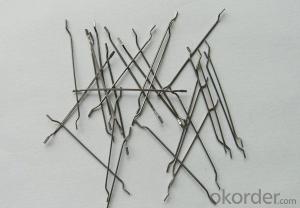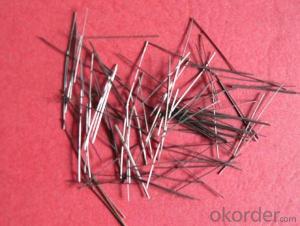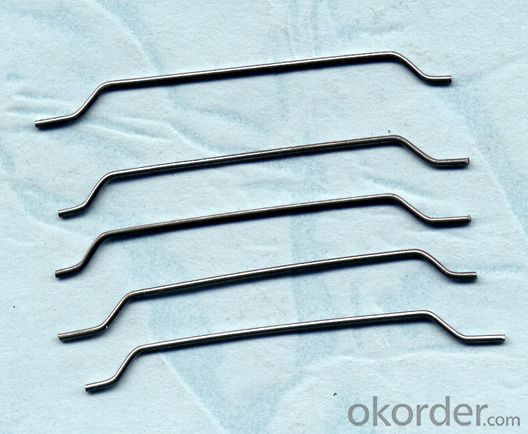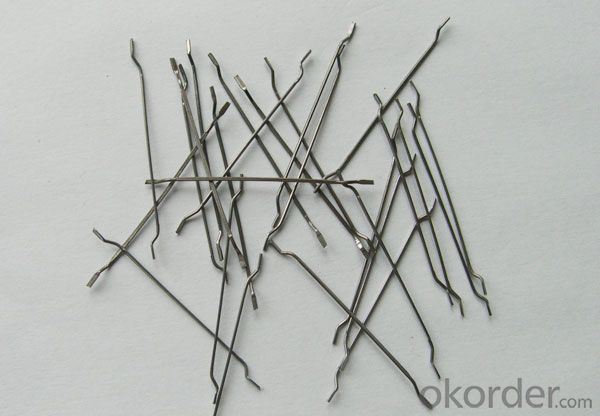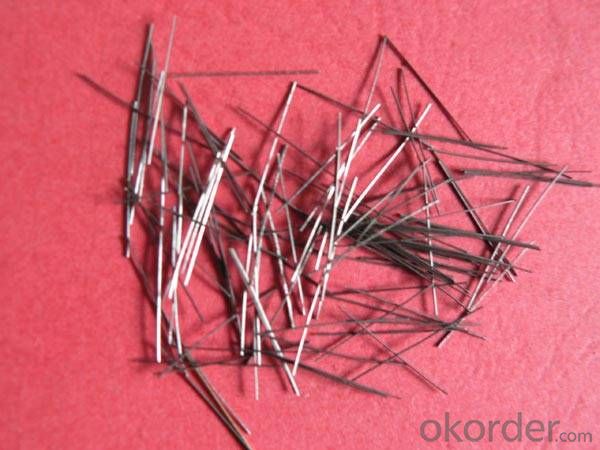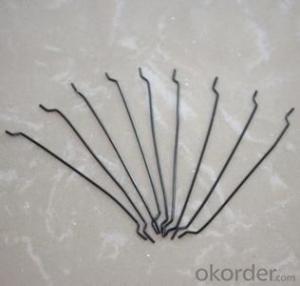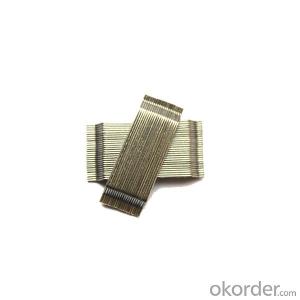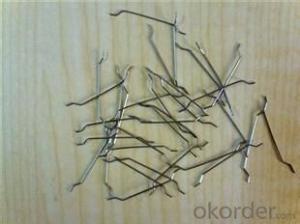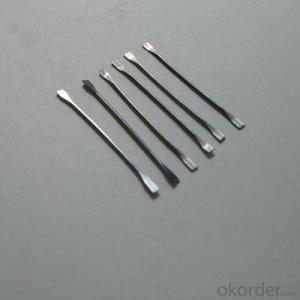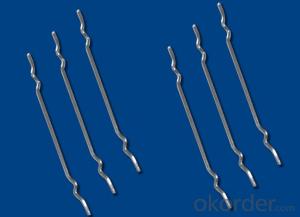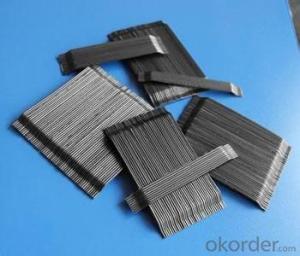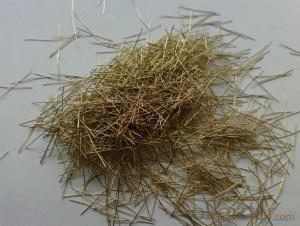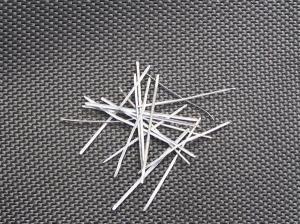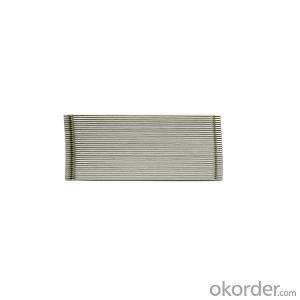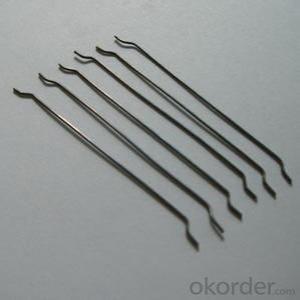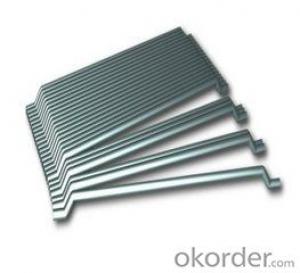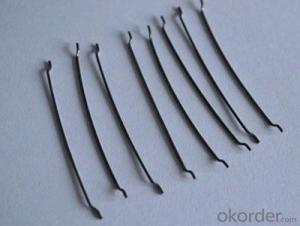Melt Extract Stainless Steel Fiber Glued for Construction Stainless Reinforced
- Loading Port:
- Tianjin
- Payment Terms:
- TT OR LC
- Min Order Qty:
- 1000 kg
- Supply Capability:
- 250000 kg/month
OKorder Service Pledge
OKorder Financial Service
You Might Also Like
Quick Details
Place of Origin: Shandong, China (Mainland), Shandong, China (Mainland)
Model Number: GLUED, glued steel fiber
Material: Steel
type: steel fiber for concrete reinforcement
material: steel wire
shape: glued together in a row
appearance: clear and bright
Product features
oncrete steel fiber is specifically to enhance concrete in its hardened state ,the uniform distribution of steel fiber throughout the concrete greatly improve concrete bonding and tensile strength ,additionally it provides exceptional load stability and durability ,as reliable and efficient concrete reinforcement material
it is widely ued in buildings ,bridges ,thin roo engineering ,highway etc
A. Tunnel pre-treatment(primary support)
B. Tunnel forming(permanent lining)
C. Slope stabilization
D. Ditch excavation support
E. Industrial floor
F. Precast concrete element
G. Concrete restoration
H. High performance concrete
Specifications
length :20-60mm
diameter :0.5MM-1.2MM
tensile strengh:>1100Mpa
| diameter | length | tensile strength | |
| 0.5mm | 35mm | 1100Mpa | |
| 0.75 | 60mm | 1100Mpa | |
| 0.9 | 60m | 1100Mpa |
Picture
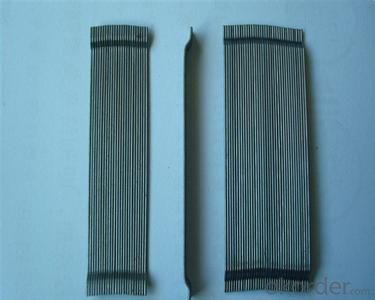
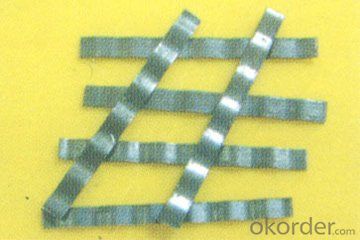
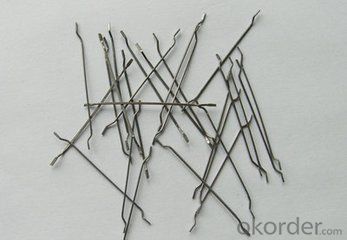
FAQ
we can produce any type steel fiber and of course we can make production according to your requirement
we have specilize in this field for almost 10 years ,with good quality and competitive price
- Q: How does the addition of melt extract stainless steel fiber impact the flowability of concrete?
- The addition of melt extract stainless steel fiber can significantly impact the flowability of concrete. Stainless steel fibers are typically added to concrete to enhance its mechanical properties, such as increasing its tensile and flexural strength, improving its durability, and reducing cracking. However, the addition of stainless steel fibers can also affect the flowability of the concrete mixture. The presence of fibers in the concrete can increase its viscosity, making it more resistant to flow. This can be particularly noticeable in high fiber volume concrete mixtures. The flowability of concrete is commonly measured using the slump test, which measures the consistency and workability of the concrete. When stainless steel fibers are added, the slump of the concrete can decrease, indicating a reduction in flowability. Nevertheless, the impact of stainless steel fibers on flowability can be controlled and managed through proper mix design and dosage. By adjusting the fiber content, the size and shape of the fibers, and the water-to-cement ratio, the flowability of the concrete can be optimized to meet the specific requirements of the project. In conclusion, the addition of melt extract stainless steel fibers can have a noticeable impact on the flowability of concrete. However, with proper mix design and dosage, the flowability can be controlled and adjusted to achieve the desired performance characteristics of the concrete.
- Q: Can melt extract stainless steel fiber enhance the resistance of concrete to freeze-thaw cycles?
- Yes, melt extract stainless steel fiber can enhance the resistance of concrete to freeze-thaw cycles. Stainless steel fibers are known for their excellent mechanical properties and durability, making them an effective reinforcement material for concrete. When added to concrete, these fibers can improve its resistance to cracking, spalling, and deterioration caused by freeze-thaw cycles. During freeze-thaw cycles, water trapped within concrete can expand when it freezes, exerting pressure on the surrounding material. This can lead to the development of cracks and ultimately, the degradation of the concrete. However, the addition of melt extract stainless steel fibers can help mitigate this issue. The fibers act as reinforcement within the concrete matrix, improving its tensile strength and ductility. This reinforcement helps to distribute the stresses caused by freeze-thaw cycles more evenly throughout the concrete, reducing the likelihood of cracking. Additionally, the stainless steel fibers can also help to bridge any cracks that may form, preventing their propagation and minimizing the potential for water ingress. Furthermore, stainless steel is highly resistant to corrosion, which is a common concern in concrete exposed to harsh environments. The use of melt extract stainless steel fibers can significantly reduce the risk of corrosion-induced deterioration, ensuring the longevity and durability of the concrete structure. In conclusion, melt extract stainless steel fiber can indeed enhance the resistance of concrete to freeze-thaw cycles. By improving the concrete's tensile strength, ductility, crack bridging capability, and corrosion resistance, these fibers contribute to the overall durability and performance of concrete in freezing and thawing conditions.
- Q: How does melt extract stainless steel fiber improve the impact resistance of concrete pavers?
- Concrete pavers' impact resistance is greatly improved by the unique properties and characteristics of melt extract stainless steel fiber. These fibers, when added to the concrete mix, act as reinforcing elements, enhancing the toughness and durability of the pavers. The main factor behind this improved impact resistance lies in the high tensile strength of stainless steel fibers. These fibers are manufactured using a melt extraction process, ensuring a consistent and uniform distribution throughout the concrete matrix. This distribution effectively disperses the stress caused by impacts, preventing the concentration of forces on specific areas of the pavers. Furthermore, the stainless steel fibers also bolster the flexural strength of the concrete pavers. This means that the pavers can endure bending forces resulting from impacts without cracking or breaking. The fibers form a reinforcement network, strengthening the cementitious matrix and halting the spread of cracks. Apart from the increased strength, stainless steel fibers also enhance the overall durability of concrete pavers. The stainless steel material boasts exceptional corrosion resistance, making it particularly advantageous in outdoor or high-moisture environments. This resistance ensures that the fibers retain their strength and integrity over time, further boosting the pavers' impact resistance. In summary, melt extract stainless steel fiber significantly enhances the impact resistance of concrete pavers by providing superior tensile strength, flexural strength, and durability. By incorporating these fibers into the concrete mix, pavers are capable of withstanding heavy loads, impacts, and other external forces without compromising their structural integrity.
- Q: How does melt extract stainless steel fiber improve the resistance to carbonation in concrete?
- Melt extract stainless steel fiber improves the resistance to carbonation in concrete by providing enhanced durability and protection against the carbonation process. When incorporated into the concrete mixture, these stainless steel fibers act as reinforcement, increasing the overall strength and resistance to various deteriorating factors, including carbonation. Carbonation is a chemical process that occurs when carbon dioxide (CO2) from the atmosphere reacts with the calcium hydroxide (Ca(OH)2) present in the concrete, forming calcium carbonate (CaCO3). This reaction reduces the alkalinity of the concrete and weakens its protective layer, leading to potential corrosion of the reinforcing steel. By adding melt extract stainless steel fiber to the concrete, the resistance to carbonation is significantly improved. The stainless steel fibers create a three-dimensional network within the concrete matrix, enhancing its mechanical properties and reducing crack formation. This network also acts as a barrier against the ingress of CO2, limiting the contact between the atmospheric carbon dioxide and the calcium hydroxide. Furthermore, the stainless steel fibers assist in maintaining the alkalinity of the concrete by reducing the penetration of carbon dioxide. The steel fibers also provide an electrochemical protection mechanism by acting as cathodic sites, preventing the corrosion of the reinforcing steel. This cathodic protection is achieved through the formation of a passive oxide layer on the surface of the stainless steel fibers, which resists corrosion and inhibits the carbonation process. Overall, the addition of melt extract stainless steel fiber to concrete improves its resistance to carbonation by enhancing its strength, reducing crack formation, limiting CO2 ingress, maintaining alkalinity, and providing cathodic protection against corrosion. This results in a more durable and long-lasting concrete structure with improved resistance to carbonation-induced deterioration.
- Q: Can melt extract stainless steel fiber be used in decorative precast concrete applications?
- Yes, melt extract stainless steel fiber can be used in decorative precast concrete applications. These fibers are commonly used in concrete to enhance its strength, durability, and resistance to cracking. In decorative precast concrete, the fibers can be added to the mix to provide additional reinforcement and prevent shrinkage cracks, which can affect the appearance and longevity of the finished product. The use of melt extract stainless steel fibers can also improve the overall aesthetic appeal of decorative precast concrete. These fibers come in various sizes and shapes, allowing for creative and intricate designs to be achieved. They can be used to create unique textures, patterns, and finishes on the surface of the concrete, enhancing its visual appeal and making it suitable for a wide range of decorative applications. Additionally, melt extract stainless steel fibers are highly corrosion-resistant, which is crucial for decorative precast concrete applications that are exposed to harsh environmental conditions or in areas with high moisture content. This ensures that the concrete remains intact and maintains its appearance over time. In summary, melt extract stainless steel fiber is a suitable choice for decorative precast concrete applications. It provides added strength, durability, and resistance to cracking, while also allowing for creative designs and maintaining the desired aesthetic appeal.
- Q: How does melt extract stainless steel fiber contribute to the post-cracking behavior of concrete?
- Melt extract stainless steel fiber plays a crucial role in enhancing the post-cracking behavior of concrete. When incorporated into the concrete mix, these fibers create a three-dimensional network within the matrix, providing a higher level of reinforcement and increasing the overall tensile strength of the material. During the early stages of cracking in concrete, the fibers help to distribute the load and limit crack propagation. By bridging across the cracks, they prevent further widening and maintain the structural integrity of the concrete. This is especially important in situations where the concrete is subjected to dynamic or cyclic loading, as it prevents the cracks from propagating and causing catastrophic failure. Moreover, the addition of melt extract stainless steel fibers significantly improves the ductility and toughness of the concrete. This means that even after the concrete has cracked, it can still withstand higher levels of deformation and absorb more energy before failure occurs. This enhanced post-cracking behavior allows the concrete to maintain its load-carrying capacity and structural performance, even under severe conditions. Furthermore, the stainless steel fibers also contribute to reducing the risk of shrinkage cracks in concrete. By restraining the shrinkage-induced tensile stresses, these fibers help to minimize the formation and propagation of cracks during the curing and drying process. This is particularly beneficial in large concrete structures or in environments with varying temperature and moisture conditions. In summary, melt extract stainless steel fiber greatly enhances the post-cracking behavior of concrete by providing increased tensile strength, crack bridging capability, improved ductility, and reduced shrinkage cracking. Its inclusion in concrete mixes ensures that the material can withstand higher levels of loading, maintain its structural integrity, and exhibit superior performance, even after cracking has occurred.
- Q: How does melt extract stainless steel fiber contribute to the crack width control of concrete?
- Melt extract stainless steel fiber plays a significant role in controlling the crack width of concrete. This type of fiber is made by melting stainless steel and then rapidly extracting it, resulting in a high-strength and ductile material. When added to concrete mixes, these fibers enhance the tensile strength and ductility of the material, which helps to control crack width. During the curing process, concrete undergoes shrinkage due to the evaporation of water. This shrinkage can lead to the formation of cracks, which may compromise the structural integrity of the concrete. By incorporating melt extract stainless steel fibers into the concrete mix, these fibers act as reinforcement, effectively bridging the cracks that may form. The high tensile strength of stainless steel fibers allows them to resist the tensile forces that cause cracks to widen. When cracks do occur, the fibers distribute stress and prevent the crack from expanding, thus controlling the crack width. This prevents the cracks from becoming larger and potentially leading to structural failure. Moreover, the ductility of stainless steel fibers allows them to undergo deformation without fracturing. This means that the fibers can absorb energy and accommodate movement within the concrete, reducing the chances of cracks widening. The combination of high strength and ductility offered by melt extract stainless steel fibers makes them an effective solution for crack width control in concrete. In summary, melt extract stainless steel fibers contribute to the crack width control of concrete by reinforcing the material, distributing stress, and preventing cracks from widening. Their high tensile strength and ductility make them an excellent choice for enhancing the overall durability and longevity of concrete structures.
- Q: Does melt extract stainless steel fiber affect the electrical conductivity of concrete?
- Yes, melt extract stainless steel fiber can affect the electrical conductivity of concrete. Stainless steel fibers, when added to concrete, can improve its electrical conductivity. The presence of stainless steel fibers creates a conductive network within the concrete matrix, allowing for the flow of electrical current. This enhanced electrical conductivity can be beneficial in applications where electrical grounding or conductivity is required, such as in the construction of electrostatic discharge (ESD) flooring or in the production of conductive concrete for electromagnetic shielding purposes. However, it is important to note that the actual impact on electrical conductivity will depend on various factors, including the dosage and distribution of the stainless steel fibers within the concrete mixture.
- Q: Can melt extract stainless steel fiber be used in tunnel shotcrete arch applications?
- Yes, melt extract stainless steel fiber can be used in tunnel shotcrete arch applications. This type of fiber is commonly used to reinforce shotcrete in various applications, including tunnels. The stainless steel fibers enhance the tensile strength and ductility of the shotcrete, making it more resistant to cracking and improving its overall durability. In tunnel shotcrete arch applications, where the shotcrete is used to create the structural support for the tunnel, the addition of melt extract stainless steel fibers can significantly enhance the strength and performance of the shotcrete arch. This allows for a more reliable and long-lasting tunnel structure.
- Q: How does melt extract stainless steel fiber affect the fatigue resistance of concrete?
- Concrete can greatly benefit from the addition of melt extract stainless steel fibers, as they enhance its fatigue resistance and overall durability. These fibers possess unique properties, including high tensile strength and excellent corrosion resistance, which contribute to their ability to reinforce the concrete and prevent cracks from spreading under cyclic loading. When melt extract stainless steel fibers are evenly dispersed throughout the concrete mixture, they create a three-dimensional network that improves the structural integrity of the material. This network helps distribute stress evenly, reducing the risk of fatigue failure by minimizing stress concentrations. Furthermore, the high corrosion resistance of stainless steel fibers ensures that they maintain their structural integrity over time. This is particularly important in concrete structures exposed to harsh environmental conditions or corrosive agents, as the fibers will not degrade or weaken due to corrosion, thus preserving their beneficial effects on fatigue resistance. In conclusion, the incorporation of melt extract stainless steel fibers into concrete significantly enhances its ability to withstand cyclic loading and repetitive stress. These fibers act as crack arresters, distribute stress more evenly, and provide long-term durability due to their corrosion resistance.
Send your message to us
Melt Extract Stainless Steel Fiber Glued for Construction Stainless Reinforced
- Loading Port:
- Tianjin
- Payment Terms:
- TT OR LC
- Min Order Qty:
- 1000 kg
- Supply Capability:
- 250000 kg/month
OKorder Service Pledge
OKorder Financial Service
Similar products
Hot products
Hot Searches
Related keywords

